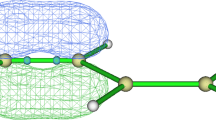Abstract
A pictorial “blackboard mnemonic” type method presented allows the molecular orbital level patterns, the numbers of non-bonding, bonding, and anti-bonding orbitals to be figured out from the actual or tentative structural formulas (or ORTEP diagrams) of saturated or unsaturated molecules or intermediates regardless of symmetry. The simple pictorial rules are illustrated on: bicyclo[p.q.0] hydrocarbons, pyridine, alkyl groups, quaternium ions, some amines, ethers, water and alcohols, and on some fluorohydrocarbons. The readily obtained MO level patterns, e.g. during rearrangements, give a handle on the qualitative behaviour of various structures or species. The method applies also to metal atom and other clusters.
Similar content being viewed by others
Abbreviations
- AO:
-
Atomic orbital
- ECI:
-
Electron count index
- H.F.:
-
Hartree-Fock
- LPI:
-
Level pattern indices
- MO:
-
Molecular orbital
- SC:
-
Structurally covariant
- SCF:
-
Self-consistent field
- SEF:
-
Structural-electronic formula
- SF:
-
Structural formula
- VB:
-
Valence-bond
- VIF:
-
Valency points interaction formula
- VP:
-
Valency point
- VL:
-
VP-VP' interaction line
- VSEPR:
-
Valence shell electron pair repulsion
References
Lewis, G. N.: Valence and the Structure of Atoms and Molecules. New York: The Chemical Catalog Co. 1923. Key historical references to the original papers of Lewis, Langmuir and others are found also p. 5 of Pauling's book, Ref. [2]
Pauling, L.: The Nature of the Chemical Bond. Ithaca, New York: Cornell University Press 1960
Hückel, E.: Z. Phys. 76, 636 (1932)
Ref. [2], pp. 387, 390
See e.g. Sinanoğlu, O., Wiberg, K. B.: Sigma MO Theory. Yale Press, N.Y./London, 1970
Hurley, A. C.: Electron Correlation in Small Molecules. New York: Academic Press 1976
Sinanoğlu, O.: J. Mol. Struct. 19, 81 (1973);
Sinanoğlu, O.: Adv. Chem. Phys. VI, 315 (1964); 14, 237 (1968); J. Phys. Chem. 66, 2283 (1962); and other papers; cf. also Ref. [20]
Starting with Lennard-Jones, J. E.: Ann. Rev. Phys. Chem. 4, 167 (1953) and references therein attempts have been made to recover the SF picture of distinct bonds and lone pairs from the MO's in the form of localized orbitals (LO's). Various approaches many of which are in use today were comparatively reviewed in Sinanoğlu, O., Tuan, D. F.: Annu. Rev. Phys. Chem. 15, 262 (1964) and further in Ref. [15]. A very recent and powerful approach is that of Luken, L. W. (1984; in press)
Coulson, C. A., Rushbrooke, G. S.: Proc. Cambridge Philos. Soc. 36, 193 (1940); Longuet-Higgins, H. C.: J. Chem. Phys. 18, 265 (1950) and other refs
See e.g. Salem, L.: The MO Theory of Conjugated Systems, p. 41. New York: W. A. Benjamin, Inc. 1966
Frost, A. A., Musulin, B.: J. Chem. Phys. 21, 572 (1953)
A series of recent papers present a new mathematical theory which provides the machinery from which the pictoral structural-electronic rules of the present paper are derived: Sinanoğlu, O.: Theor. Chim. Acta, 65, a) 243, b) 233, c) 249, d) 255, and e) 267
Coulson C. A., Streitweiser, Jr., A.: Dictionary of Pi-Electron Calculations. San Francisco: W. H. Freeman 1965
Daudel, R., Sandorfy, C.: Semi-Empirical Wave-Mechanical Calcns. on Polyatomic Molecules. New Haven/London: Yale Press 1971
For a comparison of various MO methods see e.g. Sinanoğlu O., Wiberg, K. B.: Sigma MO Theory. New Haven/London: Yale Press 1970
Dewar, M. J. S.: Pure Appl. Chem. 52, 1431 (1980)
Hoffmann, R.: J. Chem. Phys. 39, 1397 (1963)
See e.g. an inorganic chemistry text and references therein. E.g. Cotton, F. A., Wilkinson, G.: Advanced Inorganic Chemistry, 4th Edition. New York: J. Wiley 1980; also Linnett, J. W.: Wave Mechanics and Valency. New York: Methuen 1960
Sinanoğlu, O. in: Chemical Spectroscopy and Photochemistry in the Vacuum Ultraviolet. Sandorfy, C., Ausloos, P. J., Robin, M., Eds., Dordrecht: D. Reidel 1974; also Ref. [7a]
For convenient semi-empirical methods to obtain ECORR and its contribution to stable molecule binding energies see: Sinanoğlu, O., Hollister, C.: J. Am. Chem. Soc. 88, 13 (1966)
For convenient semi-empirical methods to obtain ECORR and its contribution to stable molecule binding energies see: Sinanoğlu, O., Pamuk, H. O.: J. Am. Chem. Soc. 95, 543 (1973)
Sinanoğlu, O.: Int. J. Quantum Chem. 95, 155 (1975)
Cotton and Wilkinson [18] remark that one electron MO control way of thinking about molecular shapes (as in Walsh's rules) and the VSEPR view appear so different and not reconciled with each other. We hope the discussion given about the interplay of both of these effect which are in fact in the Hartree-Fock method, sheds some light on this question
Sinanoğlu, O.: Theor. Chim. Acta (being submitted)
Sinanoğlu, O.: (to be published)
The valency point self-energies and intra-atomic (e.g. βtt) interaction strengths are calculated from the pure VP self energies (=-pure orbital I.P.) with these α's given e.g. in Burdett, J. K.: Molecular Shapes, p. 28. New York: J. Wiley (1980), or in the papers of Hoffmann, R.
Necessary and sufficient conditions will be found in a more extensive discussion of aromaticity per se; Sinanoğlu, O.: Theor. Chim. Acta (to be published)
Dewar, M. J. S., Gleicher, G. J.: J. Am. Chem. Soc. 87, 685,692 (1965); Dewar, M. J. S., deLlano, C.: J. Am. Chem. Soc. 91, 789 (1969); Also: Hess, Jr, BA, Schaad, L. J.: J. Am. Chem. Soc. 305, 2413 (1971); J. Org. Chem. 36, 3418 (1971). cf. also Aihara, J.: Chem. Phys. Lett. 73, 404 (1980)
Coulson, C. A.: Valence, 2nd Ed. Oxford Univ. Press, 1961
Author information
Authors and Affiliations
Rights and permissions
About this article
Cite this article
Sinanoğlu, O. New method for qualitative quantum chemical deductions on organic or inorganic molecules or clusters directly from structural formulas or ORTEP diagrams. Theoret. Chim. Acta 68, 251–270 (1985). https://doi.org/10.1007/BF00527534
Received:
Accepted:
Issue Date:
DOI: https://doi.org/10.1007/BF00527534




